Korg Pitchblack Portable Handleiding
Bekijk gratis de handleiding van Korg Pitchblack Portable (4 pagina’s), behorend tot de categorie DJ Gear. Deze gids werd als nuttig beoordeeld door 48 mensen en kreeg gemiddeld 4.0 sterren uit 24.5 reviews. Heb je een vraag over Korg Pitchblack Portable of wil je andere gebruikers van dit product iets vragen? Stel een vraag
Pagina 1/4

© 2012 KORG INC.
4015-2 Yanokuchi, Inagi-city, Tokyo 206-0812 Japan
Precautions
Location
Using the unit in the following locations can result in a malfunction.
• In direct sunlight
• Locations of extreme temperature or humidity
• Excessively dusty or dirty locations
• Locations of excessive vibration
• Close to magnetic elds
Power supply
Please connect the designated AC adapter to an AC outlet of the correct
voltage. Do not connect it to an AC outlet of voltage other than that for which
your unit is intended.
Interference with other electrical devices
Radios and televisions placed nearby may experience reception interference.
Operate this unit at a suitable distance from radios and televisions.
Handling
To avoid breakage, do not apply excessive force to the switches or controls.
Care
If the exterior becomes dirty, wipe it with a clean, dry cloth. Do not use liquid
cleaners such as benzene or thinner, or cleaning compounds or ammable
polishes.
Keep this manual
After reading this manual, please keep it for later reference.
Keeping foreign matter out of your equipment
Never set any container with liquid in it near this equipment. If liquid gets into
the equipment, it could cause a breakdown, re, or electrical shock.
Be careful not to let metal objects get into the equipment. If something does
slip into the equipment, unplug the AC adapter from the wall outlet. Then
contact your nearest Korg dealer or the store where the equipment was pur-
chased.
Cable check jack
Connect one end of a mono standard phone cable to the INPUT jack
and the other end to the CABLE CHECK jack.
CABLE CHECK
INPUT
When the cable is connected, the cable check function will start and the
results will be shown on the CABLE CHECK LEDs.
Normal:
Disconnected or short circuit:
TIP Stereo cables cannot be checked.
Tuning
1. Connect your instrument to the INPUT jack.
2. Press the STANDBY/ON button to turn on the power.
The TUNER ON LED will light up and the calibration settings (0–9)
and at/capo settings (-5–7) will appear in order on the display for a
few seconds (lights up blinks).
TIP If no user input is performed for up to 4 hours, the tuner will enter
the standby power mode automatically.
3. Set the calibration, at/capo setting, and meter display setting as
necessary.
4. Play all the open strings on your instrument, and tune them so that
the green LED in the polyphonic meter display lights up.
When you tune a string, the tuner will detect the string that you’re
currently tuning, and will show its precise pitch in the meter display.
TIP You can turn off the meter display by holding down the DISPLAY
button for one second or longer.
TIP The tuner will automatically detect whether your instrument is a
guitar or a 4/5/6-string bass. With normal tuning, the tuner will
indicate E, A, D, G, B, E (from thick to thin strings) for a guitar. For
a bass, the tuner will indicate Low-B, E, A, D, G, Hi-C.
Guitar E A D G B E
Bass Low-B E A D G Hi-C
5. If you want to tune a single note on your instrument, tune while
watching the meter display.
The display will indicate the note name that is closest to the pitch
you input.
Adjusting the calibration
The pitchblack PORTABLE comes from the factory with the calibration
set to A=440Hz. If an adjustment is necessary, you can do so within a
range of 436–445Hz.
安全上のご注意
ご使用になる前に必ずお読みください
ここに記載した注意事項は、製品を安全に正しくご使用い
ただき、あなたや他の方々への危害や損害を未然に防ぐた
めのものです。
注意事項は誤った取り扱いで生じる危害や損害の大きさ、
または切迫の程度によって、内容を「警告」、「注意」の 2
つに分けています。これらは、あなたや他の方々の安全や
機器の保全に関わる重要な内容ですので、よく理解した上
で必ずお守りください。
火災・感電・人身障害の危険を防止するには
以下の指示を守ってください
警告
この注意事項を無視した取り扱いをすると、死亡や重傷を負う可能性が予想
されます
・AC アダプターのプラグは、必ず AC100V の電源コン
セントに差し込む。
・AC アダプターのプラグにほこりが付着している場合
は、ほこりを拭き取る。
感電やショートの恐れがあります。
・本製品はコンセントの近くに設置し、AC アダプターの
プラグへ容易に手が届くようにする。
・次のような場合には、直ちに電源を切って AC アダプ
ターのプラグをコンセントから抜く。
○AC アダプターが破損したとき
○異物が内部に入ったとき
○製品に異常や故障が生じたとき
修理が必要なときは、コルグ・サービス・センター
へ依頼してください。
・本製品を分解したり改造したりしない。
・修理、部品の交換などで、取扱説明書に書かれてるこ
と以外は絶対にしない。
・AC アダプターのコードを無理に曲げたり、発熱する機
器に近づけない。また、AC アダプターのコードの上に
重いものをのせない。
コードが破損し、感電や火災の原因になります。
・大音量や不快な程度の音量で長時間使用しない。
大音量で長時間使用すると、難聴になる可能性があ
ります。万一、聴力低下や耳鳴りを感じたら、専門
の医師に相談してください。
・本製品に異物(燃えやすいもの、硬貨、針金など)を入
れない。
・温度が極端に高い場所(直射日光の当たる場所、暖房
機器の近く、発熱する機器の上など)で使用や保管は
しない。
・振動の多い場所で使用や保管はしない。
・ホコリの多い場所で使用や保管はしない。
・風呂場、シャワー室で使用や保管はしない。
保証規定(必ずお読みください)
本保証書は、保証期間中に本製品を保証するもので、付属
品類(ヘッドホンなど)は保証の対象になりません。保証
期間内に本製品が故障した場合は、保証規定によって無償
修理いたします。
1. 本保証書の有効期間はお買い上げ日より 1 か年です。
2.
次の修理等は保証期間内であっても有料修理となります。
• 消耗部品(電池、スピーカー、真空管、フェーダーなど)
の交換。
• お取扱い方法が不適当のために生じた故障。
• 天災(火災、浸水等)によって生じた故障。
• 故障の原因が本製品以外の他の機器にある場合。
• 不当な改造、調整、部品交換などにより生じた故障
または損傷。
• 保証 書にお買い上げ日、販売店 名が未記入の場合、
または字句が書き替えられている場合。
• 本保証書の提示がない場合。
尚、当社が修理した部分が再度故障した場合は、保証期
間外であっても、修理した日より 3 か月以内に限り無
償修理いたします。
3. 本保証書は日本国内においてのみ有効です。This war-
rantyisvalidonlyinJapan.
4. お客様が保証期間中に移転された場合でも、保証は引き
続きお使いいただけます。詳しくは、サービス・センター
までお問い合わせください。
5. 修理、運送費用が製品の価格より高くなることがありま
すので、あらかじめサービス・センターへご相談くださ
い。発送にかかる費用は、お客様の負担とさせていただ
きます。
6. 修理中の代替品、商品の貸し出し等は、いかなる場合に
おいても一切行っておりません。
本製品の故障、または使用上生じたお客様の直接、間接の
損傷につきましては、弊社はいっさいの責任を負いかねま
すのでご了承ください。
本保証書は、保証規定により無料修理をお約束するための
もので、これよりお客様の法律上の権利を制限するもので
はありません。
■お願い
1. 保証書に販売年月日等の記入がない場合は無効となりま
す。記入できないときは、お買い上げ年月日を証明でき
る領収書等と一緒に保管してください。
2. 保証書は再発行致しませんので、紛失しないように大切
に保管してください。
コルグpitchblack PORTABLE
保証書
本保証書は、上記の保証規定により無償修理をお約束するものです。
お買い上げ日 年 月 日
販売店名
アフターサービス
修理についてのご質問、ご相談は、サービス・センターへお問い合わせください。商品のお取り扱いについての
ご質問、ご相談は、お客様相談窓口へお問い合わせください。
お客様相談窓口 TEL03(5355)5056
● サービス・センター : 〒 168-0073
東京都杉並区下高井戸 1-15-12 TEL03(5355)3537
FAX03(5355)4470
Thank you for purchasing the Korg
pitchblack PORTABLE
polyphonic
tuner. To help you get the most out of your new instrument, please read
this manual carefully.
Controls
1
14
13
16
17
7
8
12
2 3 4 5
15
9
10
11
6
1. STANDBY/ON button
2. CALIB button
3. FLAT/CAPO button
4. DISPLAY button
5. MUTE button
6. Polyphonic Meter Display
7. Meter Display
8. FINE LED
9. OUTPUT jack (mono)
10. DC 9V IN jack
11. DC 9V OUT jack
12. Display
13. TUNER ON LED
14. INPUT jack (mono)
15. CABLE CHECK LED
16. CABLE CHECK jack
17. MUTE LED
Installing the battery
AA (LR6)
AA (LR6)
+
-+
-
1. Open the battery cover that’s located on the bottom of the tuner.
2. Install the batteries making sure that the polarity is correct.
3. Once the batteries are installed, close the cover.
When the battery nears the end of its life, the TUNER ON LED will
blink. When this happens, install a new battery as soon as pos-
sible.
Connections
To your effect
pedals or amps etc.
AC adapter (9V, ,
600 milliamps or greater,
sold separately)
To AC outlet
DC cascade cable
Guitar or bass
Maximum 200 milliamps
INPUT
OUTPUT
DC 9V IN
DC 9V OUT
Turn off the power to all devices before you connect an instrument
to avoid damaging your equipment.
The INPUT, CABLE CHECK and OUTPUT jacks are mono. Stereo
(TRS) cables will not work.
INPUT jack
Connect a cable from your instrument to the INPUT jack of the tuner.
OUTPUT jack
Connect a cable from the OUTPUT jack to your effect pedals or amp
etc.
The signal that is input from the INPUT jack passes through the buffer
and is output to the OUTPUT jack. By pressing the MUTE button, you
can enable or disable the mute function for the signal that is output from
the OUTPUT jack. When the mute function is enabled, the MUTE LED
will light up and the signal will not be output from the OUTPUT jack.
TIP When the tuner is in the standby power mode, the signal will not
be output from the OUTPUT jack.
DC 9 V IN jack
If you use an optional AC adapter for power, be sure that it is 9 volt
( ) and at least 600 mA.
Using an AC adapter other than what Korg recommends may
cause a malfunction or damage.
DC 9 V OUT jack
If you’re using an optional AC adapter, you can supply power to more
than one effect pedal with an optional DC cascade cable.
When using an optional DC cascade cable, make sure that the to-
tal amount of current consumption for the connected pedals does
not exceed 200 mA. Furthermore, pay attention to the required
polarity of the effect pedals when connected.
Do not connect the AC adapter to the DC 9V OUT jack. Doing so
will cause a malfunction or damage.
If the pitchblack PORTABLE is activated using a battery, you
cannot supply power from the DC 9V OUT jack.
このたびはコルグ・ポリフォニック・チューナーpitchblack PORTABLE
をお買い上げいただき、ありがとうございます。本製品を末永く
ご愛用いただくためにも、取扱説明書をよくお読みになって、正
しい方法でご使用ください。
各部の名称
1
14
13
16
17
7
8
12
2 3 4 5
15
9
10
11
6
1. STANDBY/ON ボタン
2. CALIB ボタン
3. FLAT/CAPO ボタン
4. DISPLAY ボタン
5. MUTE ボタン
6. ポリフォニック・メーター・ディスプレイ
7. メーター・ディスプレイ
8. FINELED
9. OUTPUT 端子(モノラル端子)
10.DC9VIN 端子
11.DC9VOUT 端子
12.ディスプレイ
13.TUNERONLED
14.INPUT 端子(モノラル端子)
15.CABLECHECKLED
16.CABLECHECK 端子
17.MUTELED
電池の入れ方
AA (LR6)
AA (LR6)
+
-+
-
1 本体裏側にある電池ケースのふたを開けます。
2
電池の極性に注意して電池を入れてください。
3 電池ケースのふたを閉めます。
電池寿命が近づくと、TUNERON LED が点滅します。早
めに新しい電池に交換してください。
付属の電池は動作確認用のため、通常よりも寿命が短い場合
があります。
THE FCC REGULATION WARNING (for USA)
NOTE: This equipment has been tested and found to comply with the
limits for a Class B digital device, pursuant to Part 15 of the FCC Rules.
These limits are designed to provide reasonable protection against harm-
ful interference in a residential installation. This equipment generates,
uses, and can radiate radio frequency energy and, if not installed and
used in accordance with the instructions, may cause harmful interference
to radio communications. However, there is no guarantee that interference
will not occur in a particular installation. If this equipment does cause
harmful interference to radio or television reception, which can be deter-
mined by turning the equipment off and on, the user is encouraged to try
to correct the interference by one or more of the following measures:
• Reorient or relocate the receiving antenna.
• Increase the separation between the equipment and receiver.
• Connect the equipment into an outlet on a circuit different from that to
which the receiver is connected.
• Consult the dealer or an experienced radio/TV technician for help.
If items such as cables are included with this equipment, you must use
those included items.
Unauthorized changes or modication to this system can void the user’s
authority to operate this equipment.
Notice regarding disposal (for EU)
When this “crossed-out wheeled bin” symbol is displayed on
the product, owner’s manual, battery, or battery package, it sig-
nies that when you wish to dispose of this product, manual,
package or battery you must do so in an approved manner. Do
not discard this product, manual, package or battery along with
ordinary household waste. Disposing in the correct manner will
prevent harm to human health and potential damage to the en-
vironment. Since the correct method of disposal will depend on
the applicable laws and regulations in your locality, please contact your lo-
cal administrative body for details. If the battery contains heavy metals in
excess of the regulated amount, a chemical symbol is displayed below the
“crossed-out wheeled bin” symbol on the battery or battery package.
* All product names and company names are the trademarks or registered
trademarks of their respective owners.
1 Press the CALIB button.
The calibration indication “C” will appear, and then the current value
will be shown in the display for several seconds.
2 While the current calibration setting is shown in the note name dis-
play, press the CALIB button again to adjust the setting.
Each time you press the CALIB button you will cycle through the fol-
lowing settings.
0: 440 Hz, 1: 441 Hz, 2: 442 Hz, 3: 443 Hz, 4: 444 Hz, 5: 445 Hz, 6:
436 Hz, 7: 437 Hz, 8: 438 Hz, 9: 439 Hz
3 When you have selected the desired calibration setting, wait ap-
proximately two seconds without pressing any buttons. The new
setting will blink several times in the note name display indicating
that the calibration has been set. The pitchblack PORTABLE will
automatically return to tuner mode.
Flat/capo settings
You can use at, drop D, and capo settings.
With the factory settings, “0: Normal tuning” is selected.
1. Press the FLAT/CAPO button.
The at/capo indication “F” will appear, and then the current setting
will be shown in the display for several seconds (lit blinking).
2. While this setting is shown, press the FLAT/CAPO button to select
the desired at or capo setting.
You can specify the number of semi tones by which the pitch is
raised or lowered. You can also specify drop D tuning (only the gui-
tar’s 6th string is tuned to D).
0: Normal tuning
-1:
Lowered one semitone Lowered ve semitones (at tuning) ... -5:
D: Drop D tuning
1:
Raised one semitone Raised seven semitones (capo support)... 7:
3. When you’ve made the desired setting, wait for two seconds without
pressing any buttons.
The display indication will blink several times, and the flat/capo
setting will be made. The tuner will then return to its normal state,
allowing you to tune.
TIP Since the note name indicated in the display when a single note
is detected reects the at/capo settings, at/capo tuning can be
performed by tuning to the same note as with normal tuning, even
if flat/capo settings have been made. (However, this excludes
drop D tuning.)
Meter display setting
You can specify the display pattern that’s shown in the meter’s display.
You can choose one of three patterns. With the factory settings, “1:
Regular meter” is selected.
1. Press the DISPLAY button.
The current setting is shown for several seconds in the display
(lit blinking).
2. While this setting is shown, press the DISPLAY button to select the
desired display pattern. The setting will change each time you press
the button.
1: Regular meter
Tune your instrument so that the center LED of the meter
display is lit up. The LED illumination will move from the center
toward the right if the note is sharp, or from the center toward
the left if the note is at.
2: Strobe meter
Tune your instrument so that the illumination stops owing in
the meter display. The illumination will ow from left to right if
the note is sharp, or from right to left if the note is at. When
functioning as the strobe meter, the FINE LED will light up and
the differences in the 0.1 cent pitch can be displayed.
3: Half-strobe meter
Tune your instrument so that the stream stops and only the
center LED is lit up. The right side of the meter display will
strobe if the note is sharp, and the left side of the meter dis-
play will strobe if the note is flat. When the pitch is correct,
only the center LED will light up.
3. When you’ve chosen the desired setting, wait for two seconds
without pressing any buttons.
The display indication will blink several times, and the meter
display setting will be made. The tuner will then return to its
normal state, allowing you to tune.
Specications
Tuning: 12-note equal temperament
Detection range: E0 (20.60 Hz)–C8 (4186 Hz), sine wave
Calibration range: A4 = 436–445 Hz (1 Hz steps)
Detection accuracy: ±0.1 cent
Input impedance: 1 M-ohm (tuner on)
Connects: INPUT jack, OUTPUT jack, CABLE
CHECK jack, DC 9V IN jack, DC 9V
OUT jack (Maximum 200 milliamps)
Power supply: two AA batteries (LR6) or AC adapter (9
V, , 600 milliamps or greater)
Battery life: approximately 15 hours continuous use
with tuner on (LR6, Polyphonic input
continuously, Regular meter)
Current consumption: maximum 130 mA
Dimensions (W x D x H):
161mm x 60mm x 33mm / 6.34" x 2.36"
x 1.30" (including rubber feet)
Weight: 268g / 9.45 oz. (including battery)
Included items: two AA batteries
Options (sold separately):
AC adapter (9V, , 600 milliamps)
* Appearance and specications are subject to changewithout notice for
improvement.
・雨天時の野外のように、湿気の多い場所や水滴のかか
る場所で、使用や保管はしない。
・本製品の上に、花瓶のような液体が入ったものを置か
ない。
・本製品に液体をこぼさない。
・濡れた手で本製品を使用しない。
注意
この注意事項を無視した取り扱いをすると、傷害を負う可能性
または物理的損害が発生する可能性があります
・正常な通気が妨げられない所に設置して使用する。
・ラジオ、テレビ、電子機器などから十分に離して使用す
る。
ラジオやテレビ等に接近して使用すると、本製品が
雑音を受けて誤動作する場合があります。また、ラ
ジオ、テレビ等に雑音が入ることがあります。
・外装のお手入れは、乾いた柔らかい布を使って軽く拭く。
・AC アダプターをコンセントから抜き差しするときは、
必ずプラグを持つ。
・長時間使用しないときは、電池の液漏れを防ぐために電
池を抜く。
・電池は幼児の手の届かないところへ保管する。
・長時間使用しないときは、AC アダプターをコンセント
から抜く。
・指定の AC アダプター以外は使用しない。
・他の電気機器の電源コードと一緒にタコ足配線をしな
い。
本製品の定格消費電力に合ったコンセントに接続し
てください。
・電池を過度の熱源(日光、火など)にさらさない。
・スイッチやツマミなどに必要以上の力を加えない。
故障の原因になります。
・外装のお手入れに、ベンジンやシンナー系の液体、コン
パウンド質、強燃性のポリッシャーは使用しない。
・不安定な場所に置かない。
本製品が転倒してお客様がけがをしたり、本製品が
故障する恐れがあります。
・本製品の上に乗ったり、重いものをのせたりしない。
本製品が転倒または損傷してお客様がけがをしたり、
本製品が故障する恐れがあります。
・本製品の隙間に指などを入れない。
お客様がけがをしたり、本製品が故障する恐れがあ
ります。
※ すべての製品名および会社名は、各社の商標または登録商標
です。
接続
エフェクト・ペダル、
アンプ等へ接続
ギターまたは
ベース
ACアダプターKA181(別売)
コンセントへ
エフェクト・ペダルへ
MAX200mA
DCケーブル(市販)
INPUT
DC 9V IN
DC 9V OUT
OUTPUT
接続するときは、各機器の電源をオフにしてください。
I
NPUT、OUTPUT、CABLECHECK の各端子はモノラ
ル専用です。ステレオのケーブルは使用できません。
INPUT 端子
チューニングする楽器を接続します。
OUTPUT 端子
エフェクト・ペダルやアンプ等を接続します。
INPUT端子から入力した信号は、バッファを通して
OUTPUT 端子へ出力されます。
OUTPUT 端子からの出力は、
MUTE ボタンを押すたびに、ミュートのオン、オフが切り替わり、
ミュートがオンのときには MUTELED が点灯し、OUTPUT 端
子からの出力されません。
電源待機状態のときは OUTPUT 端子からの出力はされませ
ん。
DC 9V IN 端子
AC アダプターで電源を供給する場合はオプションの AC アダプ
ター KA181(9V )を使用してください。
他の AC アダプターを使用すると、故障の原因になる可能
性があります。
DC 9V OUT 端子
オプションの AC アダプター KA181 使用時に、9V( )
で動作するエフェクト・ペダル等に電源を供給することができま
す。市販の DC ケーブルを使用すると、複数のエフェクト・ペダ
ルに電源を供給することができます。
接続するエフェクト・ペダルの消費電流の合計が 200mA を
超えないように注意してください。また、接続するエフェク
ト・ペダルの電源の極性に注意してください。
DC 9V OUT 端子に AC アダプターを接続しないでくださ
い。故障の原因となります。
電池で動作している場合は、DC 9VOUT 端子から電源は
供給できません。
ケーブル・チェック端子
両端がモノラル標準フォーン・プラグのケーブルを、INPUT 端
子と CABLECHECK 端子に接続します。
CABLE CHECK
INPUT
ケー ブル を接 続す るとケ ーブ ル・チ ェ ックが開 始し CABLE
CHECKLED に結果が表示されます。
正常時:
断線またはショートしているとき:
ステレオ・ケーブルはチェックできません。
チューニング
チューニングの方法
1. 楽器を INPUT 端子に接続します。
2. STANDBY/ON ボタンを押して、電源を入れます。
TUNERONLED が点灯し、ディスプレイに
キャリブレー
ションの設定(0 ~ 9)、フラット / カポの設定(–5 ~ 7)の順に、
それぞれ数秒間表示されます(点灯→点滅)。
最大 4 時間入力がないときは、自動的に電源待機状態にな
ります。
3.必要に応じてキャリブレーション、フラット / カポとメーター・
ディスプレイを設定します。
4.楽器のすべての開放弦を弾いて、ポリフォニック・メーター・
ディスプレイの緑色の LED が点灯するようにチューニングし
ます。
1箇所チューニングすると、チューナーが「現在チューニン
グしている弦」を見つけて、その詳細ピッチをメーター・ディ
スプレイに表示します。
DISPLAY ボタンを1秒以上長押しすることでメーター・
ディスプレイの表示をオフにすることもできます。
ギターまたは 4/5/6 弦ベースの判別は自動的に行われます。
ノーマル・チューニングのとき、ギターは太い弦から E、A、
D、G、B、E。ベースは太い弦から Low-B、E、A、D、G、
Hi-C を示します。
Guitar E A D G B E
Bass Low-B E A D G Hi-C
5. 楽器を単音でチューニングしたいときは、メーター・ディス
プレイを見てチューニングします。
ディスプレイには入力した音に一番近い音名が表示されます。
キャリブレーションの設定
キャリブレーション(チューニングするための基準ピッチ、ピア
ノ中央のラの音= A4)を設定します。工場出荷時は 0: 440Hz
に設定されています。
1. CALIB ボタンを押します。
キャリブレーションを示す「C」が表示された後、現在の設定
がディスプレイに数秒間表示されます。
2. 現在の設定が表示されている間に CALIB ボタンを押して、
キャリブレーションを設定します。
CALIB ボタンを押すたびに設定が切り替わります。
0:440Hz、1:441Hz 2:442Hz 3:443Hz、 、 、4:444Hz、
5:445Hz、6:436Hz、7:437Hz、8:438Hz 9:439Hz、
3. 設定し終えたら、ボタンを操作せずに 2 秒程度待ちます。
ディスプレイの表示が数回点滅し、キャリブレーションの設
定が完了します。そして、チューニングできる状態に戻ります。
フラット / カポの設定
フラット、ドロップD、カポタストの設定をします。
工場出荷時は「0:ノーマル・チューニング」に設定されています。
1. FLAT/CAPO ボタンを押します。
フラット / カポを示す「F」が表示された後、現在の設定がディ
スプレイに数秒間表示されます。(点灯→点滅)。
2. 現在の設定が表示されている間に FLAT/CAPO ボタンを押
して、フラット、カポの設定をします。
音のピッチを半音単位でどの位上げるか、または下げるかを
設定します。またドロップ D チューニング(ギターの 6 弦の
み D)も設定できます。
0:ノーマル・チューニング
-1:
1 半音下げる~ -5:5 半音下げる(フラット・チューニング)
D:ドロップDチューニング
1:1 半音上げる~ 7:7 半音上げる(カポタスト対応)
3. 設定し終えたら、ボタンを操作せずに 2 秒程度待ちます。
ディスプレイの表示が数回点滅し、フラット / カポの設定が
完了します。そして、チューニングできる状態に戻ります。
単音を検出したときにディスプレイに表示される音名は、フ
ラット / カポの設定が反映されているため、フラット / カポ
の設定を行っても、ノーマル・チューニング時と同じ音名に
合わせることで、フラット / カポ・チューニングすることが
できます。(ただし、ドロップ D チューニング時は除く)
メーター・ディスプレイの設定
メーター・ディスプレイの表示パターンを設定します。3 種類の
表示パターンから選びます。
工場出荷時は「1:レギュラー・メーター」に設定されています。
1. DISPLAY ボタンを押します。
現在の設定がディスプレイに数秒間表示されます(点灯→点滅)。
2. 現在の設定が表示されている間に DISPLAY ボタンを押して、
表示パターンを選びます。
押すたびに設定が切り替わります。
1:レギュラー・メーター
メーター・ディスプレイの中央の LED が点灯するよう
に楽器をチューニングします。
LED の点灯は、ピッチが高いときは中央よりも右側へ、
低いときは左側へ移動します。
2:ストロボ・メーター
メーター・ディスプレイの点灯の流れが止まるように楽
器をチューニングします。メーター・ディスプレイの点
灯はピッチが高いときは左から右へ、低いときは右から
左へ流れます。ストロボ・メーター時は FINE LED が点
灯し、0.1 セントのピッチのずれを表示することができ
ます。
3:ハーフ・ストロボ・メーター
メーター・ディスプレイの流れが止まり、中央の LED
だけが点灯するように楽器をチューニングします。ピッ
チが高いときはメーター・ディスプレイの中央より右側
で、ピッチが低いときはメーター・ディスプレイの中央
より左側でストロボを表示します。ピッチが合うと、中
央の LED だけが点灯します。
3. 設定し終えたら、ボタンを操作せずに 2 秒程度待ちます。
ディスプレイの表示が数回点滅し、メーター・ディスプ
レイの設定が完了します。そして、チューニングできる
状態に戻ります。
仕様
音律: 12 平均律
測定範囲:
E0(20.60Hz)~ C8(4186Hz)サイン波入力時
キャリブレーション範囲:A4=436 ~ 445Hz(1Hz ステップ)
測定精度: ± 0.1 セント
入力インピーダンス : 1M Ω(チューナー・オン時)
接続端子: INPUT 端子(モノラル標準フォーン・ジャッ
ク)、OUTPUT 端子(モノラル標準フォーン・ジャック)、
CABLE CHECK 端 子( モ ノ ラ ル 標 準 フォ ー ン・ジャ ッ
ク)、DC9V IN 端子、DC9V OUT 端子( 出力電流:最 大
200mA)
電源: 単 3 形アルカリ乾電池(AA)、または AC アダプター
KA181(9V )
電池寿命: チューナー・オン時、連続約 15 時間(単 3 形ア
ルカリ
乾電池使用、
ディスプレイ・モード :レギュラー・メー
ター、ポリフォニック・チューニング時)
消費電流 : 最大 130mA
外形寸法(WxDxH): 161mm×60mm×33mm(ゴム
足含む)
質量: 268g(電池含む)
付属品: 動作確認用単 3 形アルカリ乾電池× 2
オプション(別売品):
AC アダプター KA181(9V )
※仕様および外観は改良のため予告なく変更する場合があ
ります。
REMARQUE IMPORTANTE POUR LES CLIENTS
Ce produit a été fabriqué suivant des spécications sévères et des
besoins en tension applicables dans le pays où ce produit doit être
utilisé. Si vous avez acheté ce produit via l’internet, par vente par
correspondance ou/et vente par téléphone, vous devez vérier que ce
produit est bien utilisable dans le pays où vous résidez.
ATTENTION: L’utilisation de ce produit dans un pays autre que celui
pour lequel il a été conçu peut être dangereuse et annulera la garantie
du fabricant ou du distributeur. Conservez bien votre récépissé qui est
la preuve de votre achat, faute de quoi votre produit ne risque de ne
plus être couvert par la garantie du fabricant ou du distributeur.
WICHTIGER HINWEIS FÜR KUNDEN
Dieses Produkt wurde unter strenger Beachtung von Spezikationen und
Spannungsanforderungen hergestellt, die im Bestimmungsland gelten.
Wenn Sie dieses Produkt über das Internet, per Postversand und/oder mit
telefonischer Bestellung gekauft haben, müssen Sie bestätigen, dass die-
ses Produkt für Ihr Wohngebiet ausgelegt ist. WARNUNG: Verwendung
dieses Produkts in einem anderen Land als dem, für das es bestimmt ist,
verwendet wird, kann gefährlich sein und die Garantie des Herstellers oder
Importeurs hinfällig lassen werden. Bitte bewahren Sie diese Quittung als
Kaufbeleg auf, da andernfalls das Produkt von der Garantie des Herstellers
oder Importeurs ausgeschlossen werden kann.
NOTA IMPORTANTE PARA EL CONSUMIDOR
Este producto ha sido fabricado de acuerdo a estrictas especica-
ciones y requerimientos de voltaje aplicables en el país para el cual
está destinado. Si ha comprado este producto por internet, a través
de correo, y/o venta telefónica, debe usted vericar que el uso de
este producto está destinado al país en el cual reside.
AVISO: El uso de este producto en un país distinto al cual está
destinado podría resultar peligroso y podría invalidar la garantía del
fabricante o distribuidor.
Por favor guarde su recibo como prueba de compra ya que de otro
modo el producto puede verse privado de la garantía del fabricante
o distribuidor.
IMPORTANT NOTICE TO CONSUMERS
This product has been manufactured according to strict specifications
and voltage requirements that are applicable in the country in which it
is intended that this product should be used. If you have purchased this
product via the internet, through mail order, and/or via a telephone sale,
you must verify that this product is intended to be used in the country in
which you reside.
WARNING: Use of this product in any country other than that for which it
is intended could be dangerous and could invalidate the manufacturer’s or
distributor’s warranty. Please also retain your receipt as proof of purchase
otherwise your product may be disqualified from the manufacturer’s or
distributor’s warranty.
This device complies with Part 15 of the FCC Rules.
Operation is subject to the following two conditions: (1) This
device may not cause harmful interference, and (2) this device
must accept any interference received, including interference
that may cause undesired operation.
Complies with Canadian ICES-003 Class B.
Conforme au Reglement Canadian NMB-003 classe B.


Español
Precauciones
Ubicación
El uso de la unidad en las siguientes ubicaciones puede dar como
resultado un mal funcionamiento:
• Expuesto a la luz directa del sol
• Zonas de extremada temperatura o humedad
• Zonas con exceso de suciedad o polvo
• Zonas con excesiva vibración
• Cercano a campos magnéticos
Fuente de alimentación
Por favor, conecte el adaptador de corriente designado a una toma de
corriente con el voltaje adecuado. No lo conecte a una toma de corrien-
te con voltaje diferente al indicado.
Interferencias con otros aparatos
Las radios y televisores situados cerca pueden experimentar interferen-
cias en la recepción. Opere este dispositivo a una distancia prudencial
de radios y televisores.
Manejo
Para evitar una rotura, no aplique excesiva fuerza a los conmutadores
o controles.
Cuidado
Si exterior se ensucia, límpiese con un trapo seco. No use líquidos
limpiadores como disolvente, ni compuestos inamables.
Guarde este manual
Después de leer este manual, guárdelo para futuras consultas.
Mantenga los elementos externos alejados del equipo
Nunca coloque ningún recipiente con líquido cerca de este equipo,
podría causar un cortocircuito, fuero o descarga eléctrica. Cuide de que
no caiga ningún objeto metálico dentro del equipo.
Nota respecto a residuos y deshechos (solo UE)
C
uando aparezca el símbolo del cubo de basura tachado sobre
un producto, su manual de usuario, la batería, o el embalaje de
cualquiera de éstos, signica que cuando quiere tire dichos ar-
tículos a la basura, p2-ha de hacerlo en acuerdo con la normativa
vigente de la Unión Europea. No debe verter dichos artículos
junto con la basura de casa. Verter este producto de manera
adecuada ayudará a evitar daños a su salud pública y posibles
daños al medioambiente. Cada país tiene una normativa espe-
cíca acerca de cómo verter productos potencialmente tóxicos, por tanto
le rogamos que se ponga en contacto con su oficina o ministerio de
medioambiente para más detalles. Si la batería contiene metales pesados
por encima del límite permitido, habrá un símbolo de un material químico,
debajo del símbolo del cubo de basura tachado.
*Todoslosnombresdeproductosycompañíassonmarcascomercialesomarcas
registradasdesusrespectivospropietarios.Instalarlabaterí
Gracias por adquirir el afinador “Polifónico” de pitchblack PORTABLE
Korg. Para ayudarle a sacar el máximo partido de su nuevo instrumen-
to, lea detenidamente este manual.
Controles
1
14
13
16
17
7
8
12
2 3 4 5
15
9
10
11
6
1. STANDBY/ONBotón
2. CALIBBotón
3. FLAT/CAPOBotón
4. DISPLAYBotón
5. MUTEBotón
6. Pantalla del medidor polifónico
7. Pantalla del medidor
8. FINELED
9. OUTPUTJack (mono)
Hinweis zur Entsorgung (Nur EU)
Wenn Sie das Symbol mit der „durchgekreuzten Mülltonne“ auf
Ihrem Produkt, der dazugehörigen Bedienungsanleitung, der
Batterie oder dem Batteriefach sehen, müssen Sie das Produkt
in der vorgeschriebenen Art und Weise entsorgen. Dies bedeu-
tet, dass dieses Produkt mit elektrischen und elektronischen
Komponenten nicht mit dem normalen Hausmüll entsorgt wer-
den darf. Für Produkte dieser Art existiert ein separates, gesetz-
lich festgelegtes Entsorgungssystem. Gebrauchte elektrische
und elektronische Geräte müssen separat entsorgt werden, um
ein umweltgerechtes Recycling sicherzustellen. Diese Produkte müssen
bei benannten Sammelstellen abgegeben werden. Die Entsorgung ist für
den Endverbraucher kostenfrei! Bitte erkundigen sie sich bei ihrer zustän-
digen Behörde, wo sie diese Produkte zur fachgerechten Entsorgung ab-
geben können. Falls ihr Produkt mit Batterien oder Akkumulatoren ausge-
rüstet ist, müssen sie diese vor Abgabe des Produktes entfernen und
separat entsorgen (siehe oben). Die Abgabe dieses Produktes bei einer
zuständigen Stelle hilft ihnen, dass das Produkt umweltgerecht entsorgt
wird. Damit leisten sie persönlich einen nicht unerheblichen Beitrag zum
Schutz der Umwelt und der menschlichen Gesundheit vor möglichen nega-
tiven Effekten durch unsachgemäße Entsorgung von Müll. Batterien oder
Akkus, die Schadstoffe enthalten, sind auch mit dem Symbol einer durch-
gekreuzten Mülltonne gekennzeichnet. In der Nähe zum Mülltonnensymbol
bendet sich die chemische Bezeichnung des Schadstoffes. Cd oder NiCd
steht für Cadmium, Pb für Blei und Hg für Quecksilber.
*AlleProdukt-undFirmennamensindWarenzeichenodereingetrageneWarenzei-
chenderbetreffendenEigentümer.
Vielen Dank für Ihre Entscheidung zum Polyphonic Tuner
pitchblack PORTABLE
von Korg.
Bitte lesen Sie sich diese Anleitung vollständig durch, um bei
der Bedienung alles richtig zu machen.
Beschreibung
1
14
13
16
17
7
8
12
2 3 4 5
15
9
10
11
6
Français
Précautions
Emplacement
L’utilisation de cet instrument dans les endroits suivants peut en
entraîner le mauvais fonctionnement.
• En plein soleil
• Endroits très chauds ou très humides
• Endroits sales ou fort poussiéreux
• Endroits soumis à de fortes vibrations
• A proximité de champs magnétiques
Alimentation
Branchez l’adaptateur secteur mentionné à une prise secteur de
tension appropriée. Evitez de brancher l’adaptateur à une prise de
courant dont la tension ne correspond pas à celle pour laquelle
l’appareil est conçu.
Interférences avec d’autres appareils électriques
Les postes de radio et de télévision situés à proximité peuvent par
conséquent souffrir d’interférences à la réception. Veuillez dès lors
faire fonctionner cet appareil à une distance raisonnable de postes
de radio et de télévision.
Maniement
Pour éviter de les endommager, manipulez les commandes et les
boutons de cet instrument avec soin.
Entretien
Lorsque l’instrument se salit, nettoyez-le avec un chiffon propre et
sec. Ne vous servez pas d’agents de nettoyage liquides tels que du
benzène ou du diluant, voire des produits inammables.
Conservez ce manuel
Après avoir lu ce manuel, veuillez le conserver soigneusement
pour toute référence ultérieure.
Evitez toute intrusion d’objets ou de liquide
Ne placez jamais de récipient contenant du liquide près de l’instru-
ment. Si le liquide se renverse ou coule, il risque de provoquer des
dommages, un court-circuit ou une électrocution.
Veillez à ne pas laisser tomber des objets métalliques dans le boî-
tier (trombones, par ex.). Si cela se produit, débranchez l’alimenta-
tion de la prise de courant et contactez votre revendeur korg le plus
proche ou la surface où vous avez acheté l’instrument.
Note concernant les dispositions (Seulement EU)
Quand un symbole avec une poubelle barrée d’une
croix apparait sur le produit, le mode d’emploi, les
piles ou le pack de piles, cela signie que ce produit,
manuel ou piles doit être déposé chez un représen-
tant compétent, et non pas dans une poubelle ou
toute autre déchetterie conventionnelle. Disposer de
cette manière, de prévenir les dommages pour la
santé humaine et les dommages potentiels pour l’en-
vironnement. La bonne méthode d’élimination dépendra des lois
et règlements applicables dans votre localité, s’il vous plaît,
contactez votre organisme administratif pour plus de détails. Si
la pile contient des métaux lourds au-delà du seuil réglementé,
un symbole chimique est afché en dessous du symbole de la
poubelle barrée d’une croix sur la pile ou le pack de piles.
* Touslesnomsdeproduitsetdesociétéssontdesmarquescommerciales
oudéposéesdeleurdétenteurrespectif.
Nous vous remercions d’avoir choisi la accordeur polyphonique
pitchblack PORTABLE de Korg. An de pouvoir exploiter au mieux
toutes les possibilités offertes par l’instrument, veuillez lire attenti-
vement ce manuel.
Description
1
14
13
16
17
7
8
12
2 3 4 5
15
9
10
11
6
Prise INPUT
Branchez un câble de l’instrument à la prise INPUT de l’accordeur.
Prise OUTPUT
Branchez un câble de la prise OUTPUT à vos pédales d’effet, à l’ampli etc.
Le signal reçu à la prise INPUT passe par le tampon et est transmis à la
prise OUTPUT. Vous pouvez appuyer sur le bouton MUTE pour activer
ou couper la fonction de coupure (‘Mute’) du signal transmis à la prise
OUTPUT. Quand la fonction de coupure est active, le témoin MUTE s’al-
lume et le signal n’est plus transmis à la prise OUTPUT.
Astuce Quand l’accordeur est en mode de veille, le signal n’est pas
transmis à la prise OUTPUT.
Prise DC 9V IN
Si vous utilisez un adaptateur secteur optionnel pour l’alimentation, véri-
ez qu’il délivre bien 9 V ( ) et au moins 600mA.
L’utilisation d’un adaptateur secteur différent de celui recommandé
par Korg peut être source de pannes et de dommages.
Prise DC 9V OUT
Si vous utilisez un adaptateur secteur optionnel, vous pouvez alimenter
plusieurs pédales d’effets en utilisant un câble DC (CC) en cascade.
Si vous utilisez un câble DC (CC) en cascade disponible en option,
vériez que la consommation totale de courant des pédales bran-
chées n’excède pas 200mA. De plus, vériez la polarité requise
par les pédales d’effets branchées.
Ne branchez pas l’adaptateur secteur à la prise DC 9V OUT. Cela
peut entraîner des dysfonctionnements ou endommager le matériel.
Si le pitchblack PORTABLE fonctionne sur pile, il ne peut pas four-
nir d’alimentation via la prise DC 9V OUT.
Prise pour test de câble (CABLE CHECK)
Branchez une che d’un câble mono traditionnel à la prise INPUT et son
autre che à la prise CABLE CHECK.
CABLE CHECK
INPUT
Quand vous branchez le câble, la fonction de test vérie le câble et af-
che le résultat avec une témoin CABLE CHECK.
Câble correct:
Câble déconnecté ou court-circuité:
Astuce Vous ne pouvez pas vérier de câble stéréo.
Accordage
1. Branchez votre instrument à la prise INPUT.
2. Appuyez sur le bouton STANDBY/ON pour activer l’accordeur. Le
témoin TUNER ON s’allume et les réglages de calibrage (0~9) et
d’accordages “Flat/Capo” (-5~7) s’afchent dans l’ordre pendant
quelques secondes (allumé→clignotant).
Astuce Si l’accordeur ne reçoit aucun signal pendant 4 heures, il active
automatiquement son mode de veille.
3. Calibrez l’accordeur (diapason), choisissez un réglage “at/capo” et
un mode d’afchage d’accordage.
4. Jouez toutes les cordes de votre instrument à vide et accordez-les de
sorte que la diode verte s’allume sur l’afchage d’accordage poly-
phonique.
Quand vous accordez une corde, l’accordeur détecte la corde et in-
dique sa hauteur exacte avec l’afchage d’accordage.
Astuce Vous pouvez aussi couper l’afchage d’accordage en mainte-
nant le bouton DISPLAY enfoncé au moins 1 seconde.
Astuce L’accordeur détecte automatiquement si l’instrument est une
guitare ou une basse à 4/5/6 cordes. Avec un accordage normal,
l’accordeur indique E, A, D, G, B, E (de la corde la plus épaisse
à la plus ne) pour une guitare. Pour une basse, l’accordeur in-
dique B grave, E, A, D, G, C aigu.
Guitare E A D G B E
Basse B
grave
E A D G C
aigu
5. Si vous voulez n’accorder qu’une seule note sur l’instrument, utilisez
l’afchage d’accordage.
L’écran afche le nom de la note dont la hauteur se rapproche le plus
de celle de la note jouée.
Calibrage (diapason)
A la sortie d’usine, le pitchblack PORTABLE a le réglage La=440Hz.
Vous pouvez toutefois modier ce calibrage sur la plage 436~445Hz.
1 Appuyez sur le bouton CALIB.
L’indication de calibrage “C”, suivie du réglage en vigueur, est af-
chée quelques secondes.
2 Tant que le réglage de calibrage en vigueur est afché à l’écran, ap-
puyez de nouveau sur le bouton CALIB pour modier ce réglage.
Chaque pression sur le bouton CALIB sélectionne successivement
les réglages suivants.
0: 440Hz, 1: 441Hz, 2: 442Hz, 3: 443Hz, 4: 444Hz, 5: 445Hz, 6:
436Hz, 7: 437Hz, 8: 438Hz, 9: 439Hz
3
Quand vous avez choisi un réglage, attendez environ deux secondes
sans appuyer sur le moindre bouton. Le nouveau réglage clignote plu-
sieurs fois à l’écran pour indiquer qu’il est en vigueur. Le
pitchblack PORTABLE repasse automatiquement en mode d’accordeur.
Accordages ‘Flat/Capo’
Vous pouvez utiliser des accordages plus bas, en “drop D” et capo.
Avec le réglage d’usine, “0: Accordage normal” est sélectionné.
1. Appuyez sur le bouton FLAT/CAPO.
L’indication “Flat/Capo” (“F”) apparaît, suivie du réglage en vigueur,
afché quelques secondes (allumé→clignotant).
2. Tant que le réglage est afché, appuyez sur le bouton FLAT/CAPO
pour sélectionner le type d’accordage voulu.
Vous pouvez préciser l’intervalle de transposition en demi-tons. Vous
pouvez aussi choisir l’accordage “drop D” (seule la 6ème corde de la
guitare est accordée en D (ré)).
0: Accordage normal
-1: -5: Un demi-ton plus bas … Cinq demi-tons plus bas (“at”)
D: Accordage “drop D”
1: 7: Un demi-ton plus haut … Sept demi-tons plus haut (avec capo-
dastre)
3. Quand vous avez choisi un réglage, attendez environ deux secondes
sans appuyer sur le moindre bouton.
L’indication à l’écran clignote plusieurs fois et le type d’accordage
choisi entre en vigueur. L’accordeur revient en mode de fonctionne-
ment normal, permettant d’accorder l’instrument.
Astuce Vu que le nom de la note afché à l’écran pour la détection d’une
seule note reète le réglage Flat/Capo, vous pouvez effectuer
l’accordage Flat/Capo en vous accordant sur la même note que
pour l’accordage normal - même si vous avez effectué un ré-
glage Flat/Capo. (Cette remarque ne s’applique toutefois pas au
type d’accordage ‘drop D’.)
Mode d’afchage de l’accordeur
Vous pouvez choisir la façon dont l’afchage représente l’accordage.
Vous avez le choix entre trois modes. Avec le réglage d’usine,“1: Af-
chage traditionnel” est sélectionné.
1. Appuyez sur le bouton DISPLAY.
Le réglage en vigueur est afché quelques secondes (allumé →cli-
gnotant).
2. Tant que le réglage est afché, appuyez sur le bouton DISPLAY pour
sélectionner un mode d’afchage. Chaque pression sur le bouton
change l’afchage.
1: Afchage traditionnel
L’instrument est accordé quand la diode centrale est allumée. L’éclai-
rage des diodes passe du centre vers la droite si la note est trop
haute ou du centre vers la gauche si la note est trop basse.
2: Afchage stroboscopique
Accordez l’instrument jusqu’à ce que l’éclairage des diodes cesse de
se déplacer. Si la note est trop haute, l’éclairage des diodes se dé-
place de gauche à droite et si la note est trop basse, il se déplace de
droite à gauche. Quand l’accordeur est en mode d’afchage strobos-
copique, son témoin FINE s’allume et l’accordeur afche les diffé-
rences d’accord de l’ordre de 0,1 cent.
3: Afchage semi-stroboscopique
L’ instrument est accordé quand le ux cesse et la diode centrale est
allumée. Les diodes de la moitié droite s’allument successivement si
la note est trop haute et celles de la moitié gauche s’allument si la
note est trop basse. Quand la note est juste, seule la diode centrale
est allumée.
3. Quand vous avez choisi un réglage, attendez environ deux secondes
sans appuyer sur le moindre bouton.
L’indication à l’écran clignote plusieurs fois et le mode d’afchage
choisi entre en vigueur. L’accordeur revient en mode de fonctionne-
ment normal, permettant d’accorder l’instrument.
Fiche technique
Gamme: Tempérament égal (12 intervalles chroma-
tiques)
Plage de détection: E0 (20.60Hz)~C8 (4186Hz), onde sinus
Plage de calibrage du diapason:
A4= 436~445Hz (par pas de 1Hz)
Précision de la détection:
±0,1 cent
Impédance d’entrée: 1 MΩ (accordeur activé)
Prises: Prise INPUT, Prise OUTPUT, Prise CABLE
CHECK, Prise DC 9V IN, Prise DC 9V OUT
(maximum 200 mA)
Alimentation: 2 Piles AA (LR6) ou adaptateur secteur (9V,
, 600 mA ou plus)
Autonomie de la pile:: environ 15 heures en utilisation continue
avec l’accordeur activé (LR6, accord
polyphonique, afchage traditionnel)
Consommation électrique:
Maximum 130mA
Dimensions (L x P x H): 161mm x 60mm x 33mm (pieds en
caoutchouc compris)
Poids: 268g (pile comprise)
Accessoires fournis: 2 Piles AA
Options (disponibles séparément):
Adaptateur secteur (9V, , 600 mA)
* Lescaractéristiquesetl’aspectduproduitsontsusceptiblesd’êtremodiéssans
avispréalable..
CABLE CHECK-Buchse
Schließen Sie ein Ende eines Mono-Audiokabels an die INPUT-Buchse
und das andere Ende an die CABLE CHECK-Buchse an.
CABLE CHECK
INPUT
Nachdem Sie das Kabel angeschlossen haben, beginnt die Kabelprü-
fung. Das Ergebnis wird mithilfe der CABLE CHECK
-Diode
angezeigt.
Normal:
Unterbrochen oder Kurzschluss:
Tipp Stereokabel können nicht geprüft werden.
Stimmen
1. Schließen Sie Ihr Instrument an die INPUT-Buchse an.
2. Drücken Sie die STANDBY/ON-Taste, um das Stimmgerät einzu-
schalten.
Die TUNER ON-Diode leuchtet und die Kammertonfrequenzseinstel-
lungen (0–9) und Flat/Capo-Einstellungen (-5–7) erscheinen für eini-
ge Sekunden auf dem Display (Aueuchten→Blinken).
Tipp Wenn über einen Zeitraum von 4 Stunden keine Signale eingehen,
wechselt das Stimmgerät automatisch in den Bereitschaftsmodus.
3. Stellen Sie die Kammertonfrequenz ein, wählen Sie „Flat“ oder„Capo“
und die gewünschte Meteranzeige.
4. Spielen Sie alle offenen Saiten Ihres Instruments und stimmen Sie
diese, bis die grüne LED in der polyfonen Meteranzeige aueuchtet.
Wenn Sie eine Saite stimmen, weiß das Gerät, um welche Saite es
sich handelt und zeigt ihre exakte Tonhöhe im Meterbereich an.
Tipp Wenn Sie die Meteranzeige nicht benötigen, können Sie sie deak-
tivieren, indem Sie den DISPLAY-Taster mindestens 1 Sekunde
gedrückt halten.
Tipp Das Stimmgerät erkennt sofort, ob Sie eine Gitarre oder einen
4/5/6-saitigen Bass angeschlossen haben. Im Falle einer normalen
Stimmung zeigt das Gerät die Noten E, A, D, G, B, E (von dick nach
dünn) einer Gitarre an. Im Falle eines Basses zeigt das Gerät die
Noten Low-B, E, A, D, G, Hi-C an.
Gitarre E A D G B E
Bass Low-B E A D G Hi-C
5. Wenn Sie nur eine Note stimmen möchten, sollten Sie sich an der
Meteranzeige orientieren.
Das Display zeigt dann den Namen der erkannten Note an (die aber
durchaus noch zu hoch/zu tief sein kann).
Wahl der Kammertonfrequenz
Ab Werk verwendet das pitchblack PORTABLE die Kammertonfrequenz A=
440Hz. Dieser Wert kann aber im Bereich 436–445Hz geändert werden.
1 Drücken Sie den CALIB-Taster.
Im Display erscheint zuerst die Kalibrierungsanzeige „C“ und danach
die aktuelle Kammertonfrequenz.
2 Drücken Sie den CALIB-Taster erneut, während diese Anzeige er-
scheint, um die Kammertonfrequenz zu ändern.
Bei jedem Drücken des CALIB-Tasters ändert sich die Einstellung
nach folgendem Schema.
0: 440Hz, 1: 441Hz, 2: 442Hz, 3: 443Hz, 4: 444Hz, 5: 445Hz, 6:
436Hz, 7: 437Hz, 8: 438Hz, 9: 439Hz
3 Warten Sie nach Anwahl der gewünschten Kammertonfrequenz ±2
Sekunden, ohne einen anderen Taster zu drücken. Die neue Einstel-
lung blinkt wiederholt im Noten-Display, um zu bestätigen, dass sie
übernommen wird. Das pitchblack PORTABLE wechselt dann wieder
automatisch in den Stimm-Modus.
‘Flat/Capo’-Einstellungen
Hier können Sie die „Flat“-, „Drop D“- oder „Capo“-Einstellung wählen.
Die Vorgabe lautet „0:“ (normale Stimmung).
1. Drücken Sie den FLAT/CAPO-Taster.
Im Display erscheint zuerst die „F“-Anzeige (wie „Flat/Capo“) und
anschließend die aktuelle Einstellung (Leuchten→Blinken).
2. Drücken Sie den FLAT/CAPO-Taster erneut, während diese Meldung
angezeigt wird, um die gewünschte Einstellung zu wählen.
Die Anzahl der Halbtöne, um welche die Stimmung angehoben/ab-
gesenkt werden soll, kann ebenfalls eingestellt werden. Außerdem
kann die „Drop D“-Stimmung gewählt werden (die 6. wird dann zu D
gestimmt).
0: Normale Stimmung
-1: -5: Ein Halbton tiefer … Fünf Halbtöne tiefer („Flat“-Stimmung)
D: „Drop D“-Stimmung
7: 7: Ein Halbton höher … Sieben Halbtöne höher („Capo“-Stim-
mung)
3. Warten Sie nach Anwahl der gewünschten Einstellung ±2 Sekunden,
ohne einen anderen Taster zu drücken.
Das Display blinkt wiederholt, um anzuzeigen, dass die Einstellung
übernommen wird. Danach kann das Stimmgerät wieder zum Stim-
men verwendet werden.
Tipp Da der im Display angezeigte Name der erkannten Note die Flat/
Capo-Einstellungen widerspiegelt, kann eine Flat/Capo-Stimmung
vorgenommen werden, indem wie bei einer normalen Stimmung
dieselbe Note gestimmt wird, sogar wenn Flat/Capo-Einstellungen
vorgenommen wurden. (Drop D-Stimmung ist dabei ausgeschlos-
sen.)
Einstellung der Meteranzeige
Die Art, wie das Meter funktioniert, ist einstellbar. Es gibt 3 Verhaltens-
muster. Die Vorgabe lautet „1:“ (normale Meterfunktion).
1. Drücken Sie den DISPLAY-Taster.
Die aktuelle Einstellung wird im Display angezeigt (Leuchten →Blin-→Blin-Blin-
ken).
2. Drücken Sie den DISPLAY-Taster, während diese Meldung angezeigt
wird, um die gewünschte Einstellung zu wählen. Bei wiederholtem
Drücken des Tasters ändert sich die Einstellung.
1: Normale Meterfunktion
Stimmen Sie Ihr Instrument so, dass die Diode in der Mitte leuchtet.
Wenn die Note zu hoch ist, leuchten die entsprechenden Segmente
rechts. Wenn sie zu tief ist, leuchten die Segmente im linken Bereich.
2: „Strobe“-Meter
Stimmen Sie Ihr Instrument so, dass die Beleuchtung anhält. Wenn
die Dioden von links nach rechts pulsieren, ist die Note zu hoch ge-
stimmt. Rollen sie von rechts nach links, so ist die Note zu tief. Bei
der Verwendung des Strobe-Modus leuchtet die FINE-Diode auf.
Außerdem können Tonhöhenunterschiede im 0,1 Cent Bereich ange-
zeigt werden.
Instalar la batería
AA (LR6)
AA (LR6)
+
-+
-
1. Abra la tapa de la batería que se encuentra en la parte inferior del
anador.
2. Coloque las baterías asegurándose de que la polaridad es correcta.
3. Una vez colocadas las baterías, cierre la tapa.
Cuando la batería se agote, el LED TUNER ON parpadeará.
Cuando esto ocurra, instale una batería nueva lo antes posible.
Conexiones
INPUT
OUTPUT
DC 9V IN
DC 9V OUT
Cable de CC en cascada
Guitarra o bajo
A los pedales de efecto
200 mA como máximo
Adaptador de CA (9V, ,
600 mA, o superior, debe
adquirirlo por separado)
A la toma de CA
A los pedales de efecto o
amplificadores, etc.
Antes de conectar un instrumento, desactive todos los dispositivos
para evitar dañar el equipo.
Los jacks INPUT, CABLE CHECK y OUTPUT son mono. Los ca-
bles estéreo (TRS) no funcionarán.
Jack INPUT
Conecte un cable desde el instrumento al jack INPUT del afinador.
Jack OUTPUT
Conecte un cable del jack OUTPUT a los pedales de efecto, al am-
plicador, etc. Cuando active el anador, la señal del jack INPUT se
enmudecerá para permitir una anación silenciosa.
La señal que se introduce desde el jack INPUT recorre el circuito interme-
dio y se emite al jack OUTPUT. Al pulsar el botón MUTE, puede activar
o desactivar la función de silenciado para la señal que se emite desde el
jack OUTPUT. Si la función de silenciado está activada, el LED MUTE se
iluminará y la señal no se emitirá desde el jack OUTPUT.
Consejo Si el anador se encuentra en modo de ahorro de energía de
espera, la señal no se emitirá desde el jack OUTPUT.
Jack DC 9V IN
Si utiliza un adaptador de CA opcional para la alimentación, asegúrese
de que sea de 9 V ( ) y de 600mA como mínimo.
Si utiliza un adaptador de CA distinto al recomendado por Korg,
puede provocar un funcionamiento anómalo o daños.
Jack DC 9V OUT
Si utiliza un adaptador de CA opcional, puede suministrar alimentación
a más de un pedal de efectos con un cable de CC en cascada opcional.
Si utiliza un cable de CC en cascada opcional, asegúrese de que
la cantidad total de consumo eléctrico para los pedales conectados
no supera los 200mA. Además, observe la polaridad requerida de
los pedales de efectos cuando los conecte.
No conecte el adaptador de CA al jack DC 9V OUT. Si lo hiciera,
podría causar un funcionamiento anómalo o daños.
Si el pitchblack PORTABLE está activado mediante una batería,
no puede suministrar alimentación desde el jack DC 9V OUT.
Jack de comprobación del cable
Conecte un extremo de un cable de teléfono mono estándar al jack
INPUT y el otro extremo al jack CABLE CHECK.
CABLE CHECK
INPUT
Una vez conectado el cable, la función de comprobación del cable se
iniciará y los resultados se mostrarán en los LED CABLE CHECK.
Normal:
Desconectado o cortocircuito:
Consejo Los cables estéreo no se pueden comprobar.
Anación
1. Conecte el instrumento al jack INPUT.
2. Pulse el botón STANDBY/ON para activar la alimentación.
El LED TUNER ON se iluminará y los ajustes de calibración (0–9) y
los ajustes de bemol/cejilla (-5–7) aparecerán en orden en la panta-
lla durante unos segundos (se ilumina → parpadea).
Consejo Si no se realiza ninguna operación durante 4 horas, el anador
entrará automáticamente en modo de ahorro de energía de
espera.
3. Dena de la forma necesaria los ajustes de calibración, bemol/ceji-
lla y el ajuste de la pantalla del medidor.
4. Toque todas las cuerdas abiertas del instrumento y afínelas hasta
que se ilumine el LED verde de la pantalla del medidor polifónico.
Cuando ane una cuerda, el anador detectará la cuerda que está
anando y mostrará el tono exacto en la pantalla del medidor.
Consejo Puede desactivar la pantalla del medidor, manteniendo pulsa-
do el botón DISPLAY durante al menos un segundo.
Consejo El anador detectará automáticamente si el instrumento es una
guitarra o un bajo de 4/5/6 cuerdas. Con la anación normal, el
anador indicará E, A, D, G, B, E (de cuerdas gruesas a nas)
para una guitarra. Para un bajo, el anador indicará B graves, E,
A, D, G, C aguda.
Guitarra E A D G B E
Bajo B
graves
E A D G C
aguda
5. Si desea anar una única nota en el instrumento, ane mirando la
pantalla del medidor.
La pantalla indicará el nombre de la nota más próxima al tono que
está introduciendo.
Ajustar la calibración
El pitchblack PORTABLE sale de fábrica con la calibración ajustada
a A=440Hz. Si necesita ajustarla, puede denirla dentro del rango de
436–445Hz.
1 Pulse el botón CALIB.
Aparecerá la indicación de calibración “C” y el valor actual se mos-
trará en la pantalla durante algunos segundos.
2 Mientras se visualiza el ajuste de calibración actual en la pan-
talla del nombre de la nota, pulse el botón CALIB de nuevo
para denir el ajuste.
Cada vez que pulse el botón CALIB, pasa-
rá por los siguientes ajustes.
0: 440Hz, 1: 441Hz, 2: 442Hz, 3: 443Hz, 4: 444Hz, 5: 445Hz,
6: 436Hz, 7: 437Hz, 8: 438Hz, 9: 439Hz
3 Cuando haya seleccionado el ajuste de calibración deseado,
espere aproximadamente dos segundos sin pulsar ningún
botón. El nuevo ajuste parpadeará varias veces en la pantalla
del nombre de la nota, indicando que se ha ajustado la cali-
bración. El pitchblack PORTABLE volverá al modo de anador
automáticamente.
Ajustes “Flat/Capo”
Puede utilizar ajustes de bemol, “drop D” y cejilla.
Al salir de fábrica, está seleccionado el ajuste “0: Anación normal”.
1. Pulse el botón FLAT/CAPO
Aparecerá la indicación “Flat/Capo” “F” y el valor actual se
mostrará en la pantalla durante algunos segundos (iluminado
→ intermitente).
2. Mientras se muestra este ajuste, pulse el botón FLAT/CAPO
para seleccionar el ajuste deseado de bemol o cejilla.
Puede especicar el número de semitonos en que aumentará
o disminuirá el tono. También puede especicar la anación
“drop D” (sólo se ana en D la 6ª cuerda de la guitarra).
Anación normal0:
Baja un semitono… Baja cinco semitonos (anación -1: -5:
bemol)
Anación “drop D”D:
Sube un semitono… Sube siete semitonos (soporte para 7: 7:
cejilla)
3. Cuando haya seleccionado el ajuste deseado, espere aproxi-
madamente dos segundos sin pulsar ningún botón.
La indicación de la pantalla parpadeará varias veces y se
denirá el ajuste bemol/cejilla. El anador volverá al estado
normal, que le permite anar.
Consejo Como el nombre de la nota que se indica en la pantalla
cuando se detecta una única nota reeja los ajustes de
bemol/cejilla, la anación de bemol/cejilla se puede efec-
tuar anando a la misma nota que con la anación normal,
incluso si se han efectuado los ajustes de bemol/cejilla. (No
obstante, esto no incluye la anación de “drop D”.)
Ajuste de la pantalla del medidor
Puede especificar el patrón de pantalla que se mostrará en la
pantalla del medidor. Puede elegir entre tres patrones. Al salir de
fábrica, está seleccionado “1: Medidor normal”.
1. Pulse el botón DISPLAY.
El ajuste actual se muestra durante varios segundos en la
pantalla (iluminado → intermitente).
2. Mientras se muestra este ajuste, pulse el botón DISPLAY para
seleccionar el patrón de pantalla deseado. El ajuste cambiará
cada vez que pulse el botón.
1: Medidor normal
Ane el instrumento, hasta que se ilumine el LED del centro
de la pantalla del medidor. La iluminación del LED se moverá
del centro hacia la derecha si la nota es sostenida o del centro
hacia la izquierda si la nota es bemol.
2: Medidor estroboscópico
Ane el instrumento, hasta que la iluminación deje de uir en
la pantalla del medidor. La iluminación uirá de izquierda a
derecha si la nota es sostenida o de derecha a izquierda si la
nota es bemol. Cuando se utilice como un medidor estrobos-
cópico, el LED FINE se iluminará y se pueden visualizar las
diferencias en la intensidad de 0,1 cent.
3: Medidor semi-estroboscópico
Ane el instrumento, de forma que el ujo se detenga y sólo
permanezca iluminado el LED central. El estroboscopio apare-
cerá en la parte derecha de la pantalla del medidor si la nota
es sostenida y en la parte izquierda de la pantalla del medidor
si la nota es bemol. Cuando la anación sea correcta, sólo se
iluminará el LED central.
3. Cuando haya seleccionado el ajuste deseado, espere dos
segundos sin pulsar ningún botón.
La indicación en pantalla parpadeará varias veces y se deni-
rá el ajuste de la pantalla del medidor. El anador volverá al
estado normal, que le permite anar.
Especicaciones
Anación: temperamento igual de 12 notas
Rango de detección: E0 (20.60Hz)–C8 (4186Hz), onda sin-
usoidal
Rango de calibración: A4= 436–445Hz (incrementos de 1Hz)
Precisión de detección: ±0,1 centésima
Impedancia de entrada: 1 MΩ (anador activado)
Conexiones: jack INPUT, jack OUTPUT, jack CA-
BLE CHECK, jack DC 9V IN, jack DC
9V OUT (200 mA como máximo)
Alimentación: Dos baterías AA (LR6) o adaptador de
CA (9V, , 600 mA o superior)
Duración de la batería: aproximadamente 15 horas bajo un
uso continuo con el anador activado
(LR6, Afinación de polyphonic, medi-
dor normal)
Consumo eléctrico: 130mA como máximo
Dimensiones (Anch. x Prof. x Alt.):
161mm x 60mm x 33mm (incluyendo
los tacos de goma)
Peso: 268g (incluyendo la batería)
Elementos incluidos: dos pilas AA
Opciones (deben adquirirse por separado):
adaptador de CA (9V, , 600 mA)
*Elacabadoylasespecicacionesestánsujetasacambiosinprevioaviso
paramejorarelproducto.
3: Halbe „Strobe“-Funktion
Stimmen Sie Ihr Instrument so, dass nur noch die Diode in der Mitte
leuchtet. Die rechten Dioden bewegen sich, wenn die Note zu hoch
ist. Die linken Dioden bewegen sich, wenn die Note zu tief ist. Wenn
die Note richtig gestimmt ist, leuchtet nur noch die Diode in der Mitte.
3. Warten Sie nach Anwahl der gewünschten Einstellung ±2 Sekunden,
ohne einen anderen Taster zu drücken.
Das Display blinkt wiederholt, um anzuzeigen, dass die Einstellung
übernommen wird. Danach kann das Stimmgerät wieder zum Stim-
men verwendet werden.
Technische Daten
Stimmung: 12 Noten, gleichschwebende Stimmung
Erkennungsbereich: E0 (20.60Hz) – C8 (4186Hz), Sinuswelle
Kammertonfrequenz: A4= 436 – 445Hz (in 1Hz-Schritten)
Genauigkeit: ±0,1 Cent
Eingangsimpedanz: 1MΩ (Stimmfunktion aktiv)
Anschlüsse: INPUT-Buchse, OUTPUT-Buchse, CABLE
CHECK-Buchse, DC 9V IN-Buchse, DC
9V OUT-Buchse (maximal 200 mA)
Stromversorgung: Zwei AA-Batterien (LR6) oder ein AC-
Netzteil (9V, , 600mA oder mehr)
Batterielaufzeit: ±15 Stunden bei kontinuierlicher Verwen-
dung (LR6, polyfones Stimmen, normale
Meterfunktion)
Stromverbrauch: Maximal 130mA
Abmessungen (B x T x H): 161mm x 60mm x 33mm (inklusive Gum-
mifüße)
Gewicht: 268g (inklusive Batterie)
Lieferumfang: zwei AA-Batterien
Sonderzubehör: AC-Netzteil (9V, , 600 mA)
* Änderungen derAusführung undtechnischen Daten ohnevorherigeAnkündi-
gungvorbehalten.
Deutsch
Vorsichtsmaßnahmen
Aufstellungsort
Vermeiden Sie das Aufstellen des Geräts an Orten, an denen.
es direkter Sonneneinstrahlung ausgesetzt ist;
• hohe Feuchtigkeit oder Extremtemperaturen auftreten können;
• Staub oder Schmutz in großen Mengen vorhanden sind;
• das Gerät Erschütterungen ausgesetzt sein kann.
• in der Nähe eines Magnetfeldes.
Stromversorgung
Schließen Sie das optionale Netzteil nur an eine geeignete Steckdose an.
Verbinden Sie es niemals mit einer Steckdose einer anderen Spannung.
Störeinüsse auf andere Elektrogeräte
Dieser kann bei in der Nähe aufgestellten Rund-funkempfängern oder Fern-
sehgeräten Empfangsstörungen hervorrufen. Betreiben Sie solche Geräte nur
in einem geeigneten Abstand von diesem Erzeugnis.
Bedienung
Vermeiden Sie bei der Bedienung von Schaltern und Reglern unangemesse-
nen Kraftaufwand.
Reinigung
Bei auftretender Verschmutzung können Sie das Gehäuse mit einem trocke-
nen, sauberen Tuch abwischen. Verwenden Sie keinerlei Flüssigreiniger wie
beispielsweise Reinigungsbenzin, Verdünnungs- oder Spülmittel. Verwenden
Sie niemals brennbare Reiniger.
Bedienungsanleitung
Bewahren Sie diese Bedienungsanleitung gut auf, falls Sie sie später noch
einmal benötigen.
Flüssigkeiten und Fremdkörper
Stellen Sie niemals Behältnisse mit Flüssigkeiten in der Nähe des Geräts auf.
Wenn Flüssigkeit in das Gerät gelangt, können Beschädigung des Geräts,
Feuer oder ein elek-trischer Schlag die Folge sein.
Beachten Sie, daß keinerlei Fremdkörper in das Gerät gelangen. Sollte ein
Fremdkörper in das Gerät gelangt sein, so trennen Sie es sofort vom Netz.
Wenden Sie sich dann an Ihren KORG-Fachhändler.
10. Jack DC 9V IN
11. Jack DC 9V OUT
12. Pantalla
13. LED TUNER ON
14. Jack (mono)INPUT
15. LED CABLE CHECK
16. Jack CABLE CHECK
17. LED MUTE
10. DC 9V IN-Buchse
11. DC 9V OUT-Buchse
12. Display
13. TUNER ON-Diode
14. INPUT-Buchse (mono)
15. CABLE CHECK-Diode
16. CABLE CHECK-Buchse
17. MUTE-Diode
Einlegen der Batterie
AA (LR6)
AA (LR6)
+
-+
-
1. Öffnen Sie das Batteriefach an der Unterseite des Stimmgeräts.
2. Legen Sie die Batterien ein. Achten Sie auf die korrekte Polarität.
3. Schließen Sie nach dem Einlegen der Batterien die Abdeckung.
Wenn die Batterie fast erschöpft ist, beginnt die TUNER ON-Diode
zu blinken. Legen Sie dann so schnell wie möglich eine neue Bat-
terie ein.
Anschlüsse
INPUT
OUTPUT
DC 9V IN
DC 9V OUT
An die Effektpedale
oder Verstärker usw.
Netzteil (9V, , 600mA
order meh r, sold separat aly)
Zu einer St eckd ose
An die Effektpedale
Max. 200 Milliampere
Gleichstromkabel (im Fachhandel erhältlich)
Gitarre
oder Bass
Schalten Sie vor dem Anschließen eines Instruments alle Geräte
aus, um Schäden an der Ausrüstung zu vermeiden.
Die Buchsen INPUT, CABLE CHECK und OUTPUT sind mono.
Stereokabel (TRS) können hier nicht angeschlossen werden.
INPUT-Buchse
Verbinden Sie das Kabel Ihres Instruments mit der INPUT-Buchse.
OUTPUT-Buchse
Schließen Sie die OUTPUT-Buchse an ein Effektpedal oder Ihren Ver-
stärker usw. an. Wenn Sie das Stimmgerät einschalten, wird das über
die INPUT-Buchse empfangene Signal stummgeschaltet.
Das an der INPUT-Buchse eingehende Signal durchläuft den Puffer und
wird an der OUTPUT-Buchse ausgegeben. Durch Drücken der MUTE-
Taste können Sie die Stummschaltung des an der OUTPUT-Buchse
ausgegebenen Signals aktivieren oder deaktivieren. Bei aktivierter
Stummschaltung leuchtet die MUTE-Diode und an der OUTPUT-Buchse
wird kein Signal ausgegeben.
Tipp Wenn sich das Stimmgerät im Bereitschaftsmodus bendet, wird
an der OUTPUT-Buchse kein Signal ausgegeben.
DC 9V IN-Buchse
Wenn Sie mit einem optionalen Netzteil arbeiten möchten, müssen Sie
ein 9V-Modell ( ) mit minimal 600mA verwenden.
Bei Verwendung eines nicht ausdrücklich von Korg empfohlenen
Netzteils könnte das Gerät beschädigt werden.
DC 9V OUT-Buchse
Bei Verwendung eines optionalen AC-Netzteils und eines optionalen
Gleichstromkabels kann dieses Gerät weitere Effektpedale speisen.
Bedenken Sie, dass die Gesamtleistungsaufnahme der weiteren Pe-
dale nicht mehr als 200mA betragen darf. Überprüfen Sie außerdem
die Polarität der Netzteilbuchsen aller angeschlossenen Pedale.
Schließen Sie niemals ein Netzteil an die DC 9V OUT-Buchse an.
Das könnte zu Funktionsstörungen und Schäden führen.
Solange Sie den pitchblack PORTABLE mit einer Batterie betrei-
ben, kann die DC 9V OUT-Buchse nicht verwendet werden.
9. OUTPUTPrise (mono)
10. Prise DC 9V IN
11. Prise DC 9V OUT
12. Ecran
13. Témoin TUNER ON
14. Prise (mono)INPUT
15. Témoin CABLE CHECK
16. Prise CABLE CHECK
17. Témoin MUTE
1. STANDBY/ONBouton
2. CALIBBouton
3. FLAT/CAPOBouton
4. DISPLAYBouton
5. MUTEBouton
6. Afchage d’accordage poly-
phonique
7. Afchage d’accordage
8. FINETémoin
Installation de la pile
AA (LR6)
AA (LR6)
+
-+
-
1. Ouvrez le couvercle du compartiment à pile situé sous l’accor-
deur.
2. Installez les piles en veillant à ce que la polarité soit correcte.
3. Une fois que les piles sont en place, refermez le couvercle.
Quand la pile est pratiquement épuisée, le Témoin TUNER
ONclignote. Remplacez alors la pile aussi vite que possible.
Connexions
INPUT
OUTPUT
DC 9V IN
DC 9V OUT
adaptateur secteur (9V, ,
600 mA ou plus, sold separataly)
Vers une prise de courant
Guitare
ou basse
A vos pédales
d’effet ou amplis, etc..
Câble CC (disponible dans le commerce)
A vos pédales d’effet
Maximum 200 milliampères
Avant de brancher un instrument, mettez tous les dispositifs
hors tension pour éviter d’endommager votre matériel.
Les prises INPUT, CABLE CHECK et OUTPUT sont mono.
N’utilisez pas de câbles stéréo (TRS).
1. STANDBY/ON-Taster
2. CALIB-Taster
3. FLAT/CAPO-Taster
4. DISPLAY-Taster
5. MUTE-Taster
6. Polyfone Meteranzeige
7. Meteranzeige
8. FINE-Diode
9. OUTPUT-Buchse (mono)
Product specificaties
| Merk: | Korg |
| Categorie: | DJ Gear |
| Model: | Pitchblack Portable |
Heb je hulp nodig?
Als je hulp nodig hebt met Korg Pitchblack Portable stel dan hieronder een vraag en andere gebruikers zullen je antwoorden
Handleiding DJ Gear Korg
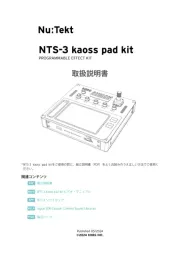
4 Februari 2025

27 Januari 2025

2 December 2024

2 December 2024

7 December 2023

19 Juni 2023

12 Juni 2023

11 Juni 2023

10 Juni 2023

1 Juni 2023
Handleiding DJ Gear
- Pro-Ject
- Universal Audio
- Nevir
- EVO
- Alesis
- Glorious
- Yamaha
- Envivo
- Genki Instruments
- Velleman
- Ion
- Steinberg
- PLAYdifferently
- Cheetah
- Fun Generation
Nieuwste handleidingen voor DJ Gear
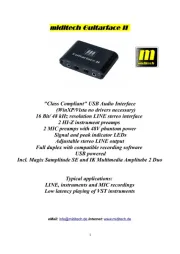
5 Augustus 2025

5 Augustus 2025
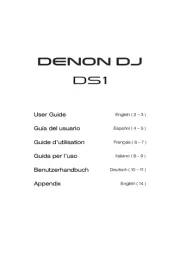
4 Augustus 2025

4 Augustus 2025
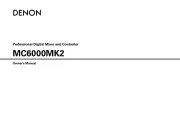
4 Augustus 2025
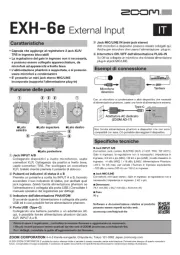
3 Augustus 2025

29 Juli 2025

29 Juli 2025

29 Juli 2025

28 Juli 2025